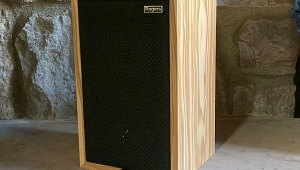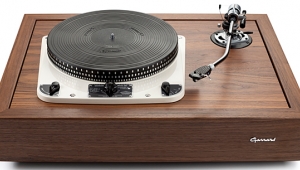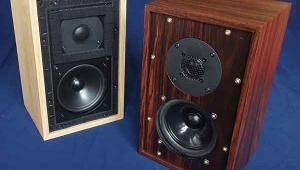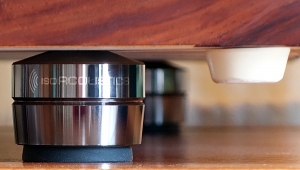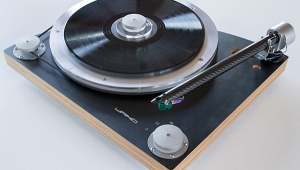| Columns Retired Columns & Blogs |
Listening #48
People love it when audio reviewers reach for that highest of all compliments: "I enjoyed the thing so much, I decided to keep it" (footnote 1). Manufacturers love it for obvious reasons. Readers love it because nuance is out of style at the moment, and the ambiguities implied by less decisive conclusions can be frustrating to adults who read with their mouths open. Publishers love it because strong, declarative statements have been scientifically proven, in double-blind reading tests, to attract subscribers.
Footnote 1: As I've mentioned in earlier columns, audio writers are generally allowed the privilege of buying review samples for lower-than-retail "industry accommodation" prices. I'm sorry to say, however, that a few people in our ranks have been known to try to wheedle better deals for themselves: poor behavior under any circumstances, and downright extortionate behavior in situations where the review has yet to be published. (As they say, intimidation is the sincerest form of flattery.) Worse still are those reviewers who seem to think that all loans are long-term loans, and to whom the phrase "I enjoyed the thing so much, I decided to keep it" actually means "I enjoyed the thing so much, I left it in my garage for six years and stopped taking the manufacturer's phone calls."
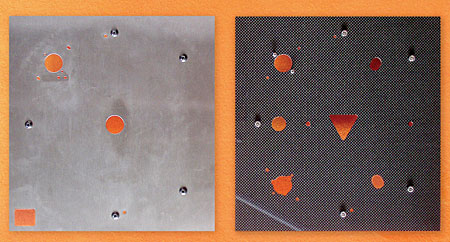
But things aren't always that simple—as I learned early in 1998, when I wrote about a product called the Pink Link for Listener magazine. The Pink Link was a modification kit for the Linn LP12 turntable, from a perennially interesting and edgy English company called Pink Triangle, and it consisted of a new drive motor, new metal top plate, and new outboard power supply. I was crazy about the Pink Link. I gave it a rave review. And I tried to buy it—but the actual review sample belonged to a Pink Triangle dealer in the Midwest, as did the LP12 to which it was attached. It was that fellow's personal record player, and he wanted it back.
I spoke to the Pink Triangle distributor, who had arranged the loan in the first place: a decent, kindly fellow, even if he didn't seem terribly enthused about the product. He had exactly one Pink Link kit in stock at the time, so I ordered it for myself.
When the new Pink Link kit arrived, I installed it in my Linn LP12. But the motor was defective right out of the box—it made a loud clicking noise (one that didn't go away after a few days, as some noises do). Then, within a week, the power supply went on the fritz. I boxed it all up and sent it back, hoping to exchange it for a new kit. But the new kit never came. I was told that Pink Triangle was developing a new version of the Pink Link—and then, a few months after that, I was told that Pink Triangle had discontinued the product. Soon after, it became apparent that Pink Triangle had ceased doing business altogether.
At last, almost a decade later, one of Pink Triangle's founders has returned to the commercial hi-fi scene with a new company, The Funk Firm. Arthur Khoubesserian, whose list of credits includes the first machined acrylic turntable platter and the first battery-powered high-end preamplifier, has finally replaced the Pink Link with a modification kit called the Vector Link, which will be distributed here in the US by the LP specialist firm Acoustic Sounds. A price for the Vector Link kit as a whole has yet to be determined, although certain individual component prices have been set.
Pink aye
Why should the consumer-electronics marketplace of 2007 roll out the red carpet for an Englishman who used to make modification kits for a single-speed Scottish turntable—and now wants his old job back?
For one thing, the Vector Link isn't the only toy Khoubesserian has brought to the sandbox: Two new turntables, the Funk ($1050 with a Moth RB250 tonearm) and the Funk Vector ($1600 with the same arm), have also arrived, and appear to be selling briskly (footnote 2). For another, the ideas on which the Vector Link is based make a whole lot of sense.

To try to understand the Vector Link, let's look back at the parts that comprised the original Pink Link kit—especially the top plate, which was at once the simplest and most revolutionary of the bunch. In the Linn Sondek LP12, the various suspended parts—the subchassis, main bearing, inner platter, outer platter, armboard, and tonearm—all hang from a thin sheet of stainless steel, which is held to the wooden frame by a combination of two (footnote 3) long bolts fastened from below, and two small wood screws fastened into hardwood blocks from above. The motor is firmly attached to the left-rear corner of this plate, and three additional, long bolts form the axes for the three suspension springs. Hardly the sort of thing that cries out for a remake—or so it would seem.
But over time, Arthur Khoubesserian determined that the LP12's top plate has the drive motor in the wrong place: If one were to accept that even the best motor will transmit unwanted vibrational energy along its drive belt, and if one were to also accept that the cantilever of a phono cartridge is least susceptible to current-inducing vibrations in its front-to-back plane of movement, then it would make sense to ensure that the drive-belt path is in line with the cantilever (to whatever extent is possible, given that the cantilever's position varies over an arc of 30° or so).
One surely wouldn't want the drive-belt path to be perpendicular to the cantilever, in which case unwanted vibrations originating at the motor would have the greatest possible effect on the output signal. But in the LP12—and, in its defense, virtually every other turntable—that's just the way things are.
The solution was simple, and Khoubesserian offered it for sale: a metal plate, finished in black, textured, semigloss paint (think: old-fashioned coffee percolator), with openings for the motor's drive pulley and mounting hardware at the left-front rather than left-rear corner.

The other two elements of the original Pink Link kit were somewhat more daunting to realize. One was a smooth, quiet, and altogether expensive DC motor, fitted with a tachometer and topped with a slender brass pulley. The other was an outboard power supply for that motor, with an advanced servo controller— and a battery and charger. For most of the time during record replay, a Pink Link–modified LP12 was disconnected from the household current.
The benefits of battery power are obvious, of the DC motor somewhat less so: After years of being told that DC motors exhibit unacceptable levels of cogging, and that servo circuits only make motors hunt (if not peck) for the right speed, how can we-the-sheeple be expected to change our minds?
As I noted in my column on the British turntable company Origin Live (Stereophile, May 2005), even an AC motor driven by a pure sinewave will exhibit noise that is mathematically related to the frequency of that wave. Driven by US current, a typical 24-pole motor will produce a noise signal at 5Hz, as contrasted with the 4.1667Hz produced by the same motor when driven by British electricity. (Again, I delight in noting that altering the size of an AC motor pulley is not enough, and that a directly driven AC-powered turntable won't sound at all the same in the UK as it does in the US.)
As I also mentioned in that earlier column, a 24-pole motor's 5Hz noise is just the fundamental: Sidebands related to various motor characteristics—the number of poles, the varying size of the internal air gap, and so forth—will also occur. The most significant of those is at 120Hz (5Hz times 24 poles) in turntables used in the US, or 99.98Hz in Europe. You may also recognize 120Hz as the second harmonic of the 60Hz AC hum we all know and love. Yikes.
Consequently, Arthur Khoubesserian is among the growing number of turntable designers who've chosen to go the DC route—and who suggest that a modern DC motor, coupled with an equally modern power supply and control circuit, will exceed the performance of an AC motor in every meaningful way.
Footnote 1: As I've mentioned in earlier columns, audio writers are generally allowed the privilege of buying review samples for lower-than-retail "industry accommodation" prices. I'm sorry to say, however, that a few people in our ranks have been known to try to wheedle better deals for themselves: poor behavior under any circumstances, and downright extortionate behavior in situations where the review has yet to be published. (As they say, intimidation is the sincerest form of flattery.) Worse still are those reviewers who seem to think that all loans are long-term loans, and to whom the phrase "I enjoyed the thing so much, I decided to keep it" actually means "I enjoyed the thing so much, I left it in my garage for six years and stopped taking the manufacturer's phone calls."
Footnote 2: You can read Mikey's positive review of the Funk Vector in the October 2006 Stereophile.
Footnote 3: In the late 1980s, that changed to three.
- Log in or register to post comments


